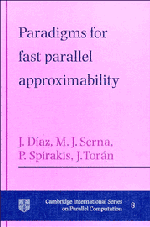Book contents
- Frontmatter
- Contents
- Preface
- 1 Introduction
- 2 Basic Concepts
- 3 Extremal Graph Properties
- 4 Rounding, Interval Partitioning and Separation
- 5 Primal-Dual Method
- 6 Graph Decomposition
- 7 Further Parallel Approximations
- 8 Non-Approximability
- 9 Syntactically Defined Classes
- Appendix 1 Definition of Problems
- Bibliography
- Author index
- Subject index
4 - Rounding, Interval Partitioning and Separation
Published online by Cambridge University Press: 19 March 2010
- Frontmatter
- Contents
- Preface
- 1 Introduction
- 2 Basic Concepts
- 3 Extremal Graph Properties
- 4 Rounding, Interval Partitioning and Separation
- 5 Primal-Dual Method
- 6 Graph Decomposition
- 7 Further Parallel Approximations
- 8 Non-Approximability
- 9 Syntactically Defined Classes
- Appendix 1 Definition of Problems
- Bibliography
- Author index
- Subject index
Summary
The approximation techniques that we consider in this chapter apply to problems that can be formulated as profit/cost problems, defined as follows: given an n × n positive matrix C and two positive vectors p and b, find an n-bit vector ƒ such that its cost C . ƒ is bounded by b and its profit p . ƒ is maximized. The value of ƒ is computed incrementally. Starting from the 0 vector, the algorithm analyzes all possible extensions incrementing one bit at a time, until it covers the n bits. Notice that the new set can have twice the size of the previous one thus leading to an exponential size set in the last step. However, we can discard some of the new assignments according to some criteria to get polynomial size sets.
Consider the interval determined by the minimum current profit and the maximum one. In the interval partitioning technique this interval is divided into small subintervals. The interval partition also gives a partition of the current set of assignment. From each class the assignment that dominates all others is selected, and the remainder discarded.
In the separation technique, the criterion used to discard possible completions insures that there are no duplicated profit values, and the profits of no three partial solutions are within a factor of each other.
The rounding/scaling technique is used to deal with problems that are hard due to the presence of large weights in the problem instance. The technique modifies the problem instance in order to produce a second instance that has no large weights, and thus can be solved efficiently.
- Type
- Chapter
- Information
- Paradigms for Fast Parallel Approximability , pp. 39 - 54Publisher: Cambridge University PressPrint publication year: 1997



